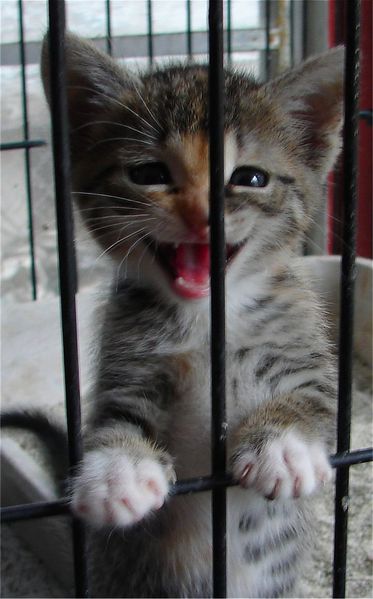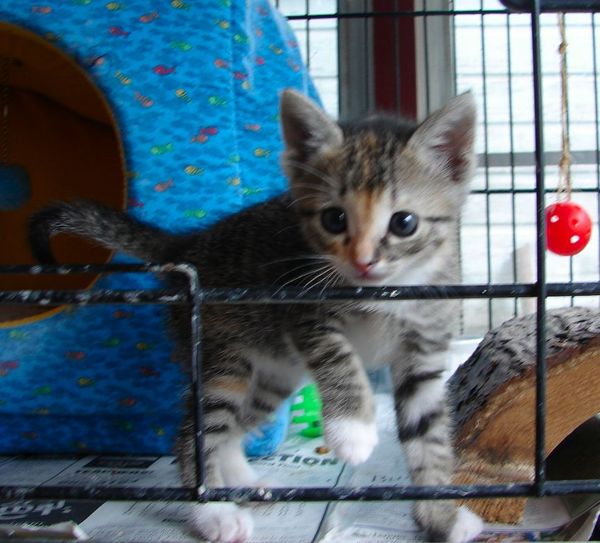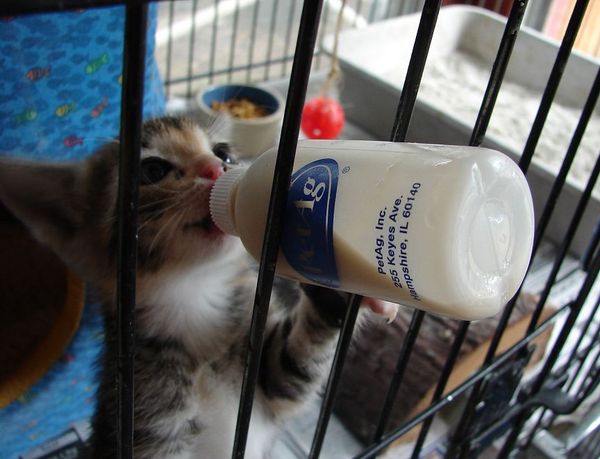





Posted by
MissDolittle
at
14:10
1 comments
![]()
Labels: kittenbaby.com, orphaned kittens
We actually have a male calico here!
Wiki says http://en.wikipedia.org/wiki/Calico_cat:
Tortoiseshell and calico describe a coloring found in cats caused by a combination of specific genetic traits. In female cats, where this trait primarily occurs, it is a result of X-inactivation, in which different patches of fur receive coding for different hair color due to the activation of an X chromosome from either the mother or the father. Calico coloring is a mix of phaeomelanin based colors (red) and eumelanin based colors (black, chocolate and cinnamon). Cats of this coloration are believed to bring good luck in the folklore of many cultures [1]; in the United States these are sometimes referred to as money cats[2].
Patterns
The mix of colors results in a cat with patches of red and black, chocolate, or cinnamon. The size of the patches can vary from a fine speckled pattern to large areas of colour. Typically, the more white a cat has, the more solid the patches of color. Dilution genes may modify the coloring, lightening the fur to a mix of cream and blue, lilac or fawn. The markings on tortoiseshell cats are usually asymmetric. Occasionally tabby patterns of eumelanistic and pheomelanistic colours are also seen (these are often then called "torbie" or "caliby").[3] Tortoiseshell also can be expressed in the point pattern. The description "tortoiseshell" (also called "calimanco" or "clouded tiger" in North America) is typically reserved for cats with brindled coats that have relatively little or no white markings, while those that are largely white with red and black patches (rather than a brindled aspect) are described as tortoiseshell-and-white (in the UK) or calico (in the United States). Tortoiseshells and calicos are not specific breeds of cat. The tortoiseshell markings appear in many different breeds. Both calico and tortoiseshell cats are almost always female. In Japan, calicos are called Mike (pronounced Mee-Kay)This pattern is especially preferred in the Japanese Bobtail breed.
Coat color genetics
Coat coloration in cats is complex, and controlled by several genes. One gene involved has two alleles: the Orange allele, O, which is the dominant form, (XO), and produces orange fur; and the "Black" allele, "o", which is the recessive form, (Xo), and produces black fur.
For a cat to be a tortoiseshell or calico, it must simultaneously express both of the alleles, O and o, which are two versions of the same gene, located at the same locus on the X chromosome. Males normally cannot do this: they can have only one allele, as they have only one X chromosome, consequently virtually all tortoiseshell or calico cats are females. Occasionally a male is born (the rate is approximately 1 in 3,000 [3]). These may have Klinefelter's syndrome, carrying an extra X chromosome, and will almost always be sterile or they may be a chimera resulting from the fusion of two differently coloured embryos.
The spotting gene causes white patches to cover the colored fur. Although there is no genetic difference, the amount of white is artificially divided into mitted, bicolour, harlequin, and van, going from almost no white to almost completely white.
In normal female tortoiseshell cats and in Klinefelter males, the position of the patches depends on which X-chromosome is active in each cell and which is inactivated to become a Barr body.
Posted by
MissDolittle
at
14:07
1 comments
![]()
Labels: male calico